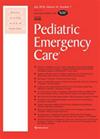摘要
目标评估各种生成式人工智能(AI)模型(ChatGPT-3.5、ChatGPT-4.0、T5、Llama-2、Mistral-Large 和 Claude-3 Opus)预测儿科急诊患者急诊严重程度指数(ESI)级别的准确性和可靠性,并评估以医学为导向的微调的影响:方法:将《ESI 手册》第 4 版中的 70 个儿科临床案例作为金标准。每个人工智能模型预测每个小节的ESI水平。计算灵敏度、特异性和 F1 分数等性能指标。通过重复测试和使用弗莱斯卡帕法测量研究者之间的可靠性来评估可靠性。使用配对 t 检验比较微调前后的模型:在未经训练的模型中,Claude-3 Opus 的性能最高,灵敏度为 80.6%(95% 置信区间 [CI]:63.6-90.7),特异度为 91.3%(95% 置信区间 [CI]:83.8-99),F1 得分为 73.9%(95% 置信区间 [CI]:58.9-90.7)。经过微调后,GPT-4.0 模型的灵敏度为 77.1%(95% CI:60.1-86.5),特异度为 92.5%(95% CI:89.5-97.4),F1 得分为 74.6%(95% CI:63.9-83.8,P),在统计上有了显著提高:生成式人工智能模型在预测儿科 ESI 水平方面表现出良好的准确性,微调可显著提高其性能和可靠性。这些研究结果表明,人工智能可作为儿科分诊的重要工具。Objective: Evaluate the accuracy and reliability of various generative artificial intelligence (AI) models (ChatGPT-3.5, ChatGPT-4.0, T5, Llama-2, Mistral-Large, and Claude-3 Opus) in predicting Emergency Severity Index (ESI) levels for pediatric emergency department patients and assess the impact of medically oriented fine-tuning.
Methods: Seventy pediatric clinical vignettes from the ESI Handbook version 4 were used as the gold standard. Each AI model predicted the ESI level for each vignette. Performance metrics, including sensitivity, specificity, and F1 score, were calculated. Reliability was assessed by repeating the tests and measuring the interrater reliability using Fleiss kappa. Paired t tests were used to compare the models before and after fine-tuning.
Results: Claude-3 Opus achieved the highest performance amongst the untrained models with a sensitivity of 80.6% (95% confidence interval [CI]: 63.6-90.7), specificity of 91.3% (95% CI: 83.8-99), and an F1 score of 73.9% (95% CI: 58.9-90.7). After fine-tuning, the GPT-4.0 model showed statistically significant improvement with a sensitivity of 77.1% (95% CI: 60.1-86.5), specificity of 92.5% (95% CI: 89.5-97.4), and an F1 score of 74.6% (95% CI: 63.9-83.8, P < 0.04). Reliability analysis revealed high agreement for Claude-3 Opus (Fleiss κ: 0.85), followed by Mistral-Large (Fleiss κ: 0.79) and trained GPT-4.0 (Fleiss κ: 0.67). Training improved the reliability of GPT models ( P < 0.001).
Conclusions: Generative AI models demonstrate promising accuracy in predicting pediatric ESI levels, with fine-tuning significantly enhancing their performance and reliability. These findings suggest that AI could serve as a valuable tool in pediatric triage.

 求助内容:
求助内容: 应助结果提醒方式:
应助结果提醒方式:


